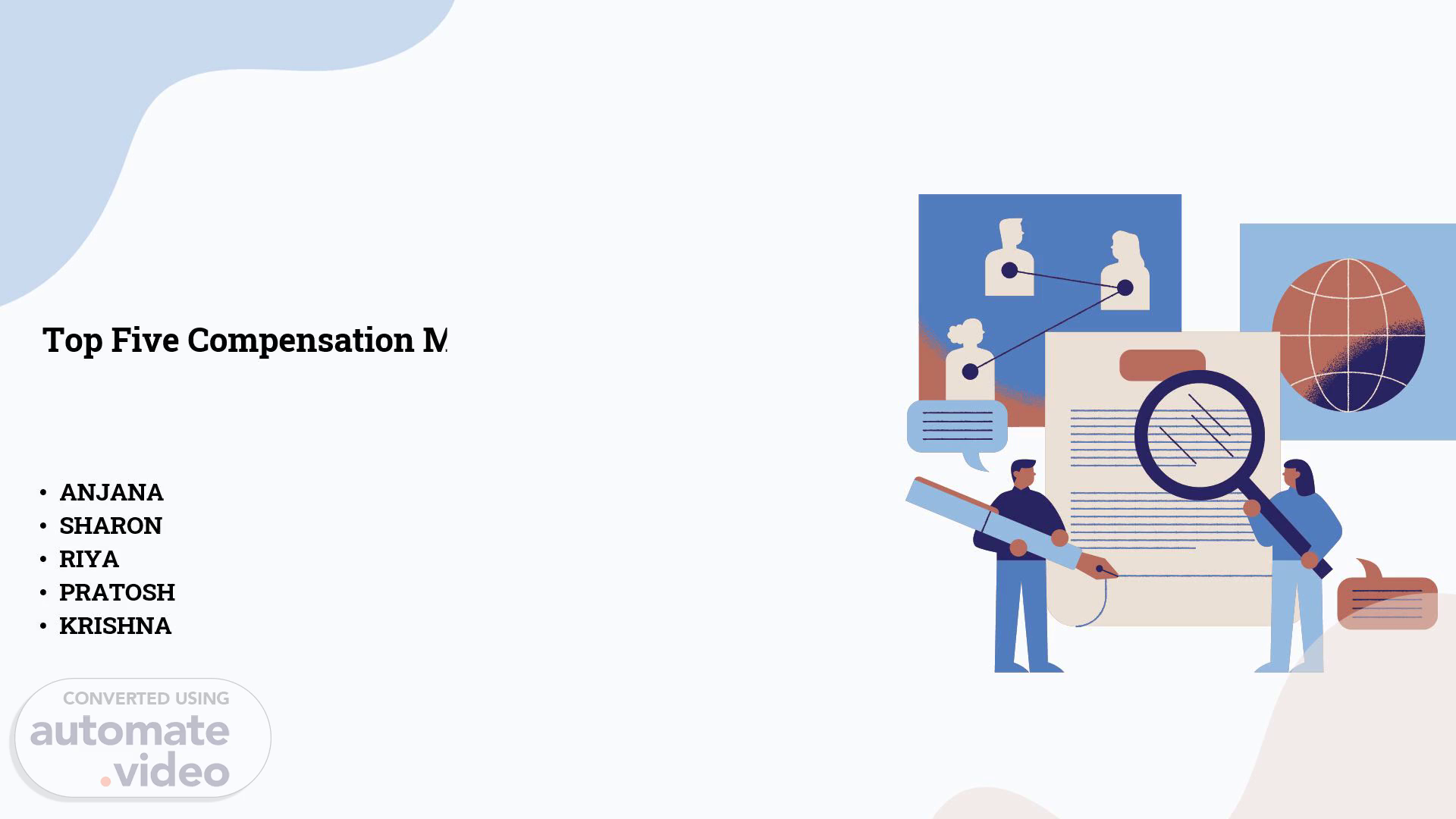Scene 1 (0s)
Top Five Compensation Management Trends for 2025.
Scene 2 (8s)
INTRODUCTION. Comprehensive Business Assessment. Collaborative Process.
Scene 3 (30s)
Pay transparency is about providing clarity on how pay is determined and it it progresses By embracing transparent pay practices HR leaders can foster Trust drive employee engagement Build a reputation as an employer of choice.
Scene 4 (1m 5s)
Data from 2025 Compensation and culture Report. 38% understand how compensation is calculated. 69% of employee say they know their total compensation. 53% of employees believe their performance reviews are subjective rather than based on objective metrics. Only 54% of employees believe they are paid fairly, with women expressing lower confidence (49%) compared to men (59%). 31% of employees don’t know their total monetary compensation (including benefits), and 62% don’t understand how their pay is calculated. Only 5% say their company has used new technology, like AI, to evaluate and expose pay equity gaps..
Scene 5 (1m 31s)
Weaknesses. Opportunities. Threats. FLEXIBLE BENEFITS PLANS & HOLISTIC WELLNESS PROGRAMS.
Scene 6 (1m 56s)
Industry Examples & Market Adoption Industry Practices: Tech Leaders (Google): On-site fitness, mindfulness training, mental health resources. Global Corporations (Amazon): Healthcare services, fitness centers, virtual wellness programs. Financial Services (Amex): Mental health counseling, stress management, flexible work. Market Adoption: Up to 20% higher productivity and lower absenteeism with wellbeing initiatives. Wellness spending now a standard part of competitive compensation..
Scene 7 (2m 17s)
AI systems continuously analyse market data to provide real-time salary comparisons, eliminating the need for manual surveys..
Scene 8 (2m 39s)
Real-Time Pay Adjustments. Skill-Based Pay Updates.
Scene 9 (3m 5s)
BENEFITS FOR ORGANIZATIONS. Attracts and retains top talent Ensures fairness and transparency Reduces administrative burden Supports pay-for-performance culture.
Scene 10 (3m 15s)
EXAMPLES. E-commerce Sector Amazon – AI powered payroll and workforce optimization Technology Giants Google – AI driven pay equity analysis Microsoft – AI powered performance-based compensation Automobile Industry Tesla – AI driven Incentive structures JPMorgan Chase – AI for financial sector compensation Indian IT Sector Infosys & TCS – AI powered workforce analytics.
Scene 11 (3m 30s)
Pay linked to certifications and skills. Determine your key strengths and competitive advantages..
Scene 12 (3m 48s)
Increased employee motivation & job satisfaction.
Scene 13 (4m 10s)
Google & Apple boost pay 20-30% for AI/certifications.
Scene 14 (4m 28s)
The New Wave of ESG Compensation (2025 & Beyond) By 2025, with more than 77% of S&P 500 companies using ESG-linked pay, there's been a shift away from if to how to link pay to purpose effectively. Post-pandemic strategy is going beyond mere adoption to more rigorous and impactful incentive structures. This strategic pivot is driven by a number of key trends that characterize the new era of corporate accountability..
Scene 15 (5m 11s)
Innovations in ESG Metrics: Social & Environmental Post-2024, incentive design has moved from simple tracking to business-integrated, transformative change. Social Innovation: Beyond Representation The emphasis in Diversity Equity and Inclusion (DEI) has moved from simple representation targets to nuanced, outcome-focused goals that make inclusion part of the fabric of the corporate culture. Microsoft (Tech): In its 2025 plan, Microsoft expands its DEI metrics beyond hiring to include employee sentiment scores from underrepresented groups and accessibility improvements in its product lines. BlackRock: Beginning in 2025, BlackRock links a portion of its executive bonuses to the diversity of its portfolio management teams and the successful launch of investment products focused on underserved communities. Unilever (Retail): Unilever pioneers a new model in 2025 by linking executive long-term incentives to socioeconomic diversity within its global workforce, measured by promotion velocity and retention rates..
Scene 16 (6m 6s)
The Future Outlook: The Integrated & Accountable Executive The post-pandemic era requires that ESG compensation be both ambitious and defensible, as a powerful driver of change, rather than a symbolic gesture. The companies that will be most innovative will be those that are able to weave ESG into their core business strategy. Strategic Best Practices 2025 and Beyond: Prioritize Dynamic & Material Goals: Move from static, three-year targets to adaptive goals based on most important ESG issues that drive long-term value creation. Embrace "Double Materiality": Incentivize executives on the basis not only of the impact of ESG issues on the company's finances, but also of the impact the company's operations have on society and the environment. Cascade Incentives Deeper: The most effective programs will include more than the C-suite, as they cascade specific, role-relevant ESG incentives down to all employees in order to develop a shared sense of accountability and purpose..
